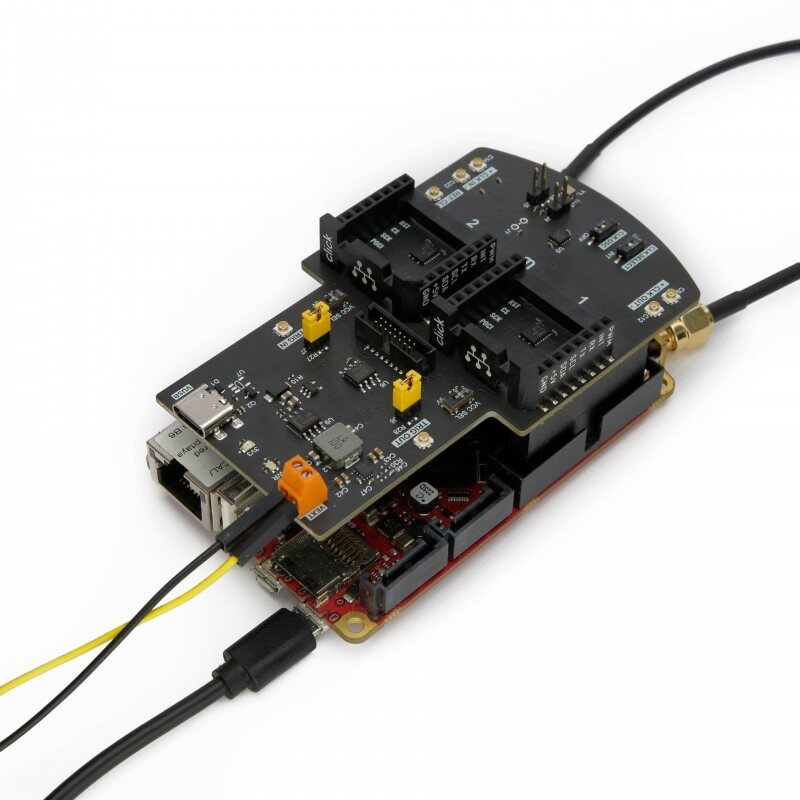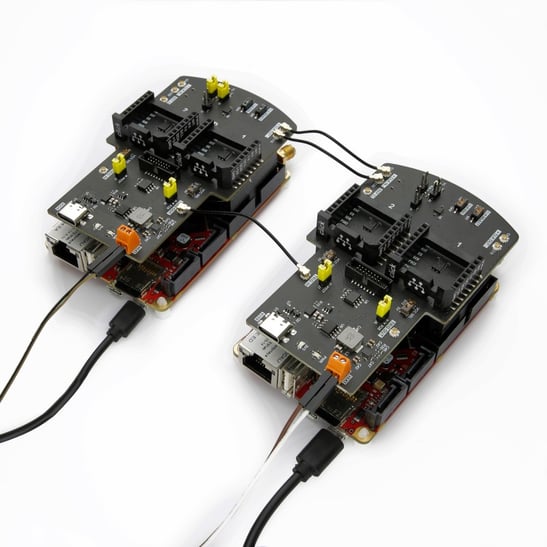The Long-Awaited Red Pitaya Click Shield
-
Posted by
 Red Pitaya Team
, January 8, 2024
Red Pitaya Team
, January 8, 2024

We are excited to share the good news of a long-awaited product, as the Red Pitaya Click Shield, which was developed in collaboration with MIKROE, is just about to be released.
.jpg?width=618&height=618&name=RedPitaya-Click-Shield-dark%20(1).jpg)
What is the Red Pitaya Click Shield?
Red Pitaya Click Shield provides a fresh set of tools for your favorite “Swiss Army Knife for engineers”, exponentially increasing its versatility. Have you ever wanted to add a high-resolution ADC or a GPS module to your Red Pitaya, but there was no easy way to connect it? Perhaps you just wanted a more versatile synchronization option or power your Red Pitaya with an industrial power supply?
The Red Pitaya Click Shield offers some exciting features:
- Two mikroBUS™ sockets, allowing you to interface with more than 1,500 MIKROE Click board™
- High-performance clock and trigger synchronization between multiple Red Pitaya units.
- Powering a Red Pitaya board through an external power supply (12-24 V or via a USB-C connector).
MIKROE Click Boards Compatibility
The main feature of the Red Pitaya Click Shields is upgrading your Red Pitaya board with two MIKROE Click board™ devices. With over 1,500 different Click boards™ available, this opens up endless hardware extension possibilities. From additional ADC and DAC channels, GPS, Wi-Fi, and other communication modules to simple temperature sensors. With the help of bidirectional level-shifting voltage translators, you can use any Click board™, regardless of whether it operates at a 3V3 or 5V logic voltage range.
Additionally, all MIKROE Click boards™ have the same standard mikroBUS™ pinout, allowing you to easily swap one for another, making the Click Shield a versatile and reusable add-on for your Red Pitaya board.
Clock and trigger synchronization
Red Pitaya Click Shield provides endless flexibility when dealing with clock and trigger synchronization. The Click Shield utilizes the U.FL connector standard for connecting clock and trigger signals. Here are the options:
- External clock sources:
- Connect an external clock source to the Click Shield
- Use the Click Shield 125 MHz on-board oscillator
- Transmit the Click Shield clock signal to other devices.
The connection provides minimal clock signal delay between multiple Red Pitaya units, providing synchronization that’s even better than the Red Pitaya X-Channel system. The same principle is applied to the external trigger.
Using the U.FL connector standard, sharing the clock and trigger signals between multiple Red Pitaya units and other devices becomes trivial. 
External power
Powering your Red Pitaya is also easier. With a Red Pitaya Click Shield, the previous restrictions are gone – you can now power the Click Shield and Red Pitaya board with a wide voltage range from 12 V to 24 V DC, or use a USB-C external power supply. You thus don’t have to rely on the original Red Pitaya power supply, but can use a better one if available.
Logic analyzer
We took care to connect the Red Pitaya GPIO pins to a special logic analyzer connector, and so even with a Click Shield the ability to spy on CAN, SPI, UART, or I2C signals remains intact.
We can’t wait to see what awesome project you’re going to create with this exciting new tool!
Read more about the new Red Pitaya Click Shield in our documentation or visit MIKROE.
About the Red Pitaya Team
The Red Pitaya editorial team consists of engineers, researchers, and product experts who develop and test cutting-edge open-source test & measurement solutions.
Our mission is to make advanced instrumentation accessible to everyone — from students and educators to leading research labs worldwide.



